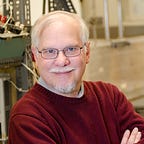Hugs and Handshakes
I just returned from the 2018 Geological Society of America (GSA) Annual Meeting, held in Indianapolis. The Paleontological Society (PS) and other professional organizations meet jointly with GSA. Not the most exotic locality, but the host city did what it was required to do; provide enough hotel rooms and nearby restaurants and bars to serve some 6,000 scientists for 4+ days. Although a beautiful locality is a bonus (I am thinking of you, Vancouver), that is not why I enjoy going to these meetings. Instead, it is because I can reconnect, both professionally and socially, with my many colleagues and friends who share my interest in the history of life. I have known some of these people for four decades. Others I met only a few years ago or am just becoming introduced to. One thing is universal; we greet each other with handshakes or hugs. There is a genuine sense of warmth to the atmosphere of the meeting. The closest parallel I can think of is large family reunion; there is the core membership who have known each other for years and can swap stories of how things used to be. And there are the new members, being introduced for the first time and being made to feel at home. Much of the closeness also comes from the somewhat incestuous (figuratively) nature of our science. Paleontology is a relatively small discipline; many of us had the same PhD advisors or our advisors had the same advisors, making us academic “cousins.” We send each other our best students to continue their education.
The “business” of the meeting, of course, is science. Conferences are where we first see cutting edge research that will appear in the next year or two in journals. Although a tiny number of talks and posters are dreadful (really only one this year), most are interesting and worth listening too. But what I really come for are those few talks that make me go “wow, that is really interesting!” What is especially exciting is when the speaker is one of younger scientists. They leave me reassured that our discipline will be in good hands and amazed how far we have come in concepts, data, and methods. It is great to talk to these bright young paleontologists and to have one’s biases challenged. Paleontology is not an intellectual backwater!
Some of the business takes place away from the conference center. I had two lunches and a dinner that were focused on papers I am writing or research I plan to do. We planned out my new graduate student’s thesis project.
It is exciting to see how the gender balance of the field has shifted. Although there have always been female paleontologists at these meetings, they were rare enough to stand out. Now they are a prominent proportion of all attendees and appear to be approaching near equity among the younger cohorts. Their accomplishments are also being respected. This year the great Kay Behrensmeyer finally received the Paleontological Society Medal, the society’s highest honor and long long overdue. And Eugenie Scott, former director of National Center for Science Education, was honored for her many achievements in protecting the teaching of evolution.
There is also increasing visibility of our LGBTQ members. Their presence within our ranks was not a topic for discussion when I started out. It shocked many twenty years ago when a male awardee openly thanked his male partner at our society business meeting. This year, more than fifty people showed up at the GSA LGBTQ social, when only twenty were expected.
There has been an accompanying sea change in the social dynamics of the conference. Behavior, particularly towards young women, that was at least tacitly tolerated, is now explicitly addressed. Both the GSA and the PS have published codes of conduct. There is also an active component to this. Many meeting attendees wore a RISE button (Respectful Inclusive Scientific Events). Anyone feeling harassed or observing someone being harassed was encouraged to report the incident to one of these individuals. There was at least one episode this year that I am aware of that this was utilized.
There are many scientific conferences; each has its own dynamic. Some of it is related to size and duration of the meeting. The national GSA meeting can have on the order of 7,000 attendees and last four full days. In addition to this, the Paleontological Society usually sponsors a free “short course” on a particular topic the day before the meeting starts. By the last day, I have heard dozens of 15-minute long talks and seen a similar number of poster presentations. By that point, I have seen everyone I want to see and am pretty burned out. Many people leave before the end. There is a reason one hopes to avoid speaking on the afternoon of the last day. For the previous two years I spoke in the first session of the first day; that was sweet. The rest of the meeting was worry free. This year, karma paid me back by putting me in the dreaded last session. Not as bad I feared.
I always come back from these meetings totally excited about the science, full of new ideas for my own research, and happy to have seen my many friends and colleagues. Even in Indianapolis.
